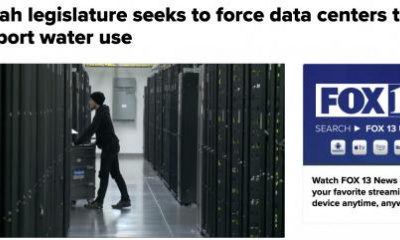Utah lawmakers on Wednesday unveiled two pieces of legislation aimed at helping the Great Salt Lake that advocates are calling “historic.”
One is a resolution that sets a concrete goal for improving the lake. The other is a bill that will direct sales tax revenue toward water conservation.
A measurable goal for the Great Salt Lake
The one-page resolution, sponsored by Sen. Nate Blouin, D-Salt Lake City, lists a number of reasons why the lake is important — among the clauses are the lake’s “significant lake-effect snowfall to the Wasatch Front’s ski areas”; “the numerous mineral extraction companies and their 5,000+ employees”; “a $1.4 billion input to the state of Utah economy”; and the “important nesting and feeding habitat for over 10 million birds.”
But perhaps most notable is the stated goal of returning the lake level to 4,198 feet, a number that Blouin said is the minimum required to maintain the ecosystem.
The state lacks a “measurable objective,” making it hard to know what exactly lawmakers mean when they say “save” the Great Salt Lake, says Zachary Frankel, executive director of the Utah Rivers Council. “Everybody wants to save it, the Republicans, the Democrats, they all want to save it. But there’s no goal.”
“We’ve set up a great framework that’s going to get water back to the lake, but we haven’t established a target that gives us an overarching goal to work towards,” added Blouin, speaking to reporters at a news conference at the state Capitol.
To reach 4,198 feet, the lake would need roughly 6.4 million acre-feet of water. The last time the lake was at that level, Blouin said, was in 2012. Currently, the lake is around 4,190 feet, leaving levels low and vulnerable to toxic dust.
“There’s no specific timeline here,” Blouin said. “The date is, unofficially, as soon as possible.”
According to Frankel, the quickest path to 4,198 feet would require the communities and industries in the Great Salt Lake basin to stop using water for the next two years, while receiving average precipitation.
More funding for water conservation
Sponsored by Rep. Joel Briscoe, D-Salt Lake City, HB286 would create a new funding mechanism for the state to acquire water rights and launch conservation projects.
“We need a permanent water right for the Great Salt Lake that’s sizable in volume. So the legislation, as proposed, would redirect one-sixteenth of a cent in sales tax revenue to go to the Great Salt Lake account to raise water levels by buying water,” Frankel said.
In short, lawmakers want to repurpose a construction account established in 2015 to fund the Bear River Development and the Lake Powell Pipeline, two large water diversion projects currently sitting in limbo. For the next five years, the Water Infrastructure Restricted Account, which collects about one-sixteenth of a cent from sales tax revenue, would funnel money into the Great Salt Lake Account.
The Lake Powell Pipeline is a $3 billion project that would take 80,000 acre-feet of Utah’s Colorado River allotment from the Glen Canyon Dam to the St. George area. The Bear River Development would divert 220,000 acre-feet out of the Bear River, the Great Salt Lake’s largest water source, for northern Utah communities.
Both projects are controversial, with environmental advocates saying they will accelerate harm done to the state’s water ecosystems and could result in costly litigation, while proponents say they are essential to support Utah’s growth.
But construction is still likely years away, and the idea is that while both projects sit idle, lawmakers should use the funds sitting in the water infrastructure account to help the Great Salt Lake, which poses an immediate threat to the health of the Wasatch Front.
“The drying up and potential disappearance in the Great Salt Lake is the existential crisis of our economy,” said Briscoe. “We dismissed the Great Salt Lake. We ignored it. We failed to appreciate it for too long.”
Briscoe said there are experts looking at the Great Salt Lake that have determined it could be gone in five years, and his legislation is designed to react to that timeline.
Frankel says the water infrastructure account snowballed into $179 million since it was created — that money will stay put. And Briscoe said his bill does not hinder efforts for the Bear River project or the various appropriations to the Department of Natural Resources for dam safety, cloud seeding and water rights adjudication.
But the roughly $60 million in sales tax revenue that the account generates annually would give the Utah Division of Forestry, Fire and State Lands greater buying power, amounting to roughly $300 million over five years.
“One of the biggest obstacles (to saving the Great Salt Lake) is just coming up with enough funding to make a difference,” Joel Ferry, director of the Utah Department of Natural Resources, said during a Salt Lake County Watershed Symposium last fall.
The Utah Division of Forestry, Fire and State Lands can hold water rights permanently, “so giving them money for them to acquire water is the main goal here,” Frankel said.

.jpg)






